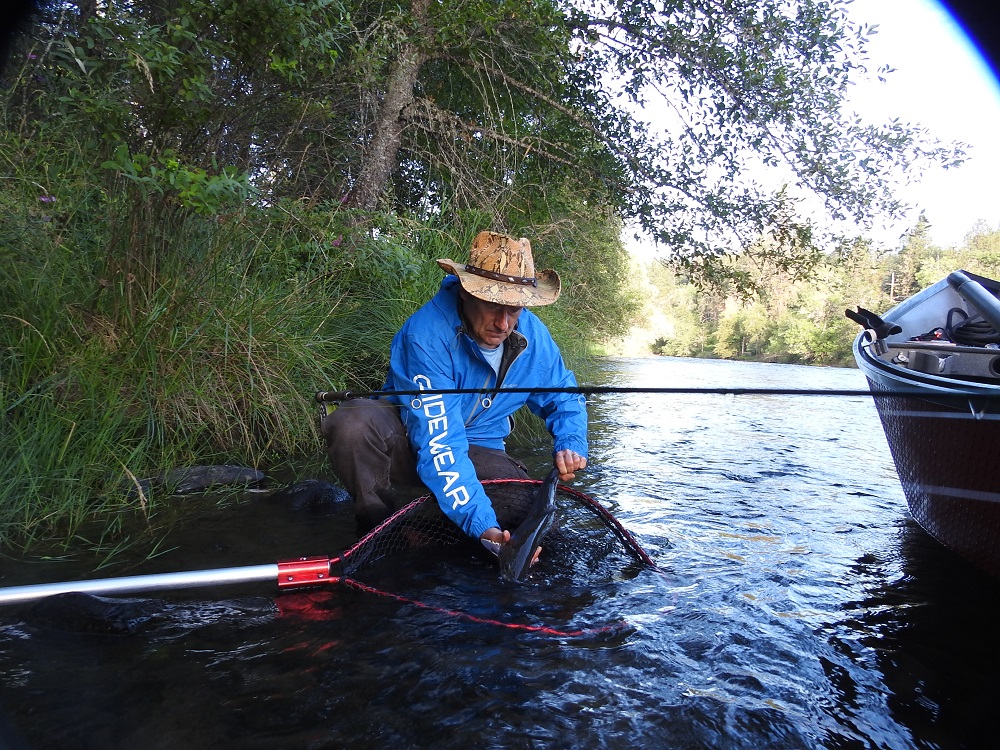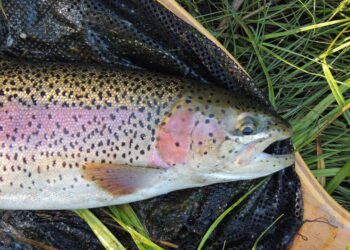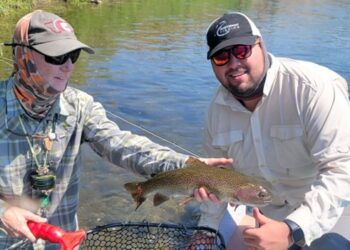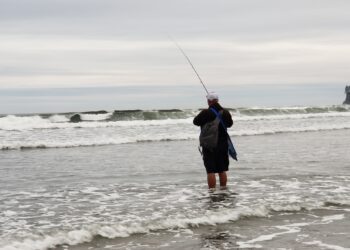We slid down out of a tail-out and into the next riffle. I was in the bow, tilted into the front brace, rod up. “Cast left, this side has the fast water.” Twenty-three-year-old Cole McAuliffe, of Chrome Tales Guide Service, was on the sticks, his curly hair around his shoulders. McAuliffe flicked the right oar and lifted the left. Water ran down off the blade and the boat caught in the current. I flopped an inelegant short cast, looped an upstream mend, and watched the two-fly rig catch the foam line past a jagged submerged rock. Sloppy but perfect. The float plunged and I lifted the rod into a summer steelhead that rocketed out of the shallow slot and into the air, twisting three feet above the water.

Oh, there is something about hooking a summer steelhead on a fly when you know the leader is 10-pound test and you have a lot of river!
We were only 20 minutes off the launch and no one on the water ahead of us or behind us. Is this not the great Rogue River? Where is everybody? But then I remembered, it was the hottest week of the summer and the rafts and tubes would hit the river about 11 in the morning. And I would be with them, except I’m older and smarter. We met each other earlier this summer when I helped McAuliffe find a highly efficient German shorthair chukar dog, and after the deal was done we both saw a drift-boat shaped hole in our August calendars.
Out of the launch with the sun just breaking over the Cascades, McAuliffe charged the boat straight across the river to a favorite run where a fat sea-run cutthroat waited for us. Now, barely ten minutes later, we had a steelhead on the line, on 10-pound Maxima, charging downstream.
Down through the tailout of the next riffle we followed it, and before I could get the fish’s head up, it tail-walked again. Moments later, McAuliffe grabbed the net and made one stab for it when the fish was close, as if we had been fishing together for years instead of just the last 20 minutes. I jumped over the side into the shallows and lifted the wild fish out of the net and showed it to the young guide with the Wild Bill Hickock haircut, shooting my camera. But the fish was done with handshakes and flipped out of my grasp. Five pounds of shiny summer steel, back into the water from whence she came.
There are not as many good summer run rivers in Oregon as there used to be, as hatchery managers have ratcheted back on the good times we enjoyed in the ’80s and ’90s. Did we have too much fun then and now we have to work harder for our fish? Guess so. McAuliffe, by my calculations, was born at the end of that era and, as fishing guide is his chosen profession in the 2020’s, he is probably going to hear from a lot of middle-aged clients about how it used to be. Today a fishing guide has to work harder. And get up earlier in the morning.

Now I had steelhead lenses on, reading water left and right, with Cole sliding the boat from one good slot to the other. Depending on the water, I used my fiberglass 5-weight to swing a fly or his 6-weight TFO with the float and two-fly rig. McAuliffe said the summer run steelhead season has started stronger than last year and while a lot of guides are using spinning gear, he prefers to stick with the fly rod.
At the business end is a No. 10 beadhead with a heavily weighted stonefly nymph to get to the bottom fast. We adjusted the float to run about 2X the depth of each run. We looked back upstream. Still no one behind us. Still no one ahead. We had first water all the way to the takeout. And trout in every drift. A few were hatchery rainbows and a few were smolts, and they beat the steelhead to the fly.
Trout chased the float, they chased the stonefly out of the water on the retrieves and swiped at the point fly, and I expected a fish on every drift. Get up early in the morning to beat the floaters and the cone-lickers. Go for the trout fishing and let the steelhead surprise you.




















